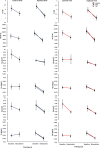Using Low Levels of Stochastic Vestibular Stimulation to Improve Balance Function
- PMID: 26295807
- PMCID: PMC4546608
- DOI: 10.1371/journal.pone.0136335
Using Low Levels of Stochastic Vestibular Stimulation to Improve Balance Function
Abstract
Low-level stochastic vestibular stimulation (SVS) has been associated with improved postural responses in the medio-lateral (ML) direction, but its effect in improving balance function in both the ML and anterior-posterior (AP) directions has not been studied. In this series of studies, the efficacy of applying low amplitude SVS in 0-30 Hz range between the mastoids in the ML direction on improving cross-planar balance function was investigated. Forty-five (45) subjects stood on a compliant surface with their eyes closed and were instructed to maintain a stable upright stance. Measures of stability of the head, trunk, and whole body were quantified in ML, AP and combined APML directions. Results show that binaural bipolar SVS given in the ML direction significantly improved balance performance with the peak of optimal stimulus amplitude predominantly in the range of 100-500 μA for all the three directions, exhibiting stochastic resonance (SR) phenomenon. Objective perceptual and body motion thresholds as estimates of internal noise while subjects sat on a chair with their eyes closed and were given 1 Hz bipolar binaural sinusoidal electrical stimuli were also measured. In general, there was no significant difference between estimates of perceptual and body motion thresholds. The average optimal SVS amplitude that improved balance performance (peak SVS amplitude normalized to perceptual threshold) was estimated to be 46% in ML, 53% in AP, and 50% in APML directions. A miniature patch-type SVS device may be useful to improve balance function in people with disabilities due to aging, Parkinson's disease or in astronauts returning from long-duration space flight.
Conflict of interest statement
Figures






Similar articles
-
Improving balance function using vestibular stochastic resonance: optimizing stimulus characteristics.Exp Brain Res. 2011 Apr;210(2):303-12. doi: 10.1007/s00221-011-2633-z. Epub 2011 Mar 26. Exp Brain Res. 2011. PMID: 21442221
-
Using low levels of stochastic vestibular stimulation to improve locomotor stability.Front Syst Neurosci. 2015 Aug 24;9:117. doi: 10.3389/fnsys.2015.00117. eCollection 2015. Front Syst Neurosci. 2015. PMID: 26347619 Free PMC article.
-
Subthreshold stochastic vestibular stimulation affects balance-challenged standing and walking.PLoS One. 2020 Apr 10;15(4):e0231334. doi: 10.1371/journal.pone.0231334. eCollection 2020. PLoS One. 2020. PMID: 32275736 Free PMC article.
-
Enhancement of Vestibular Motion Discrimination by Small Stochastic Whole-body Perturbations in Young Healthy Humans.Neuroscience. 2023 Feb 1;510:32-48. doi: 10.1016/j.neuroscience.2022.12.010. Epub 2022 Dec 16. Neuroscience. 2023. PMID: 36535577
-
Noise and vestibular perception of passive self-motion.Front Neurol. 2023 Apr 26;14:1159242. doi: 10.3389/fneur.2023.1159242. eCollection 2023. Front Neurol. 2023. PMID: 37181550 Free PMC article. Review.
Cited by
-
Optimal Design of Galvanic Vestibular Stimulation for Patients with Vestibulopathy and Cerebellar Disorders.Brain Sci. 2023 Sep 16;13(9):1333. doi: 10.3390/brainsci13091333. Brain Sci. 2023. PMID: 37759934 Free PMC article.
-
Postural control during galvanic vestibular stimulation in patients with persistent perceptual-postural dizziness.J Neurol. 2019 May;266(5):1236-1249. doi: 10.1007/s00415-019-09255-7. Epub 2019 Feb 26. J Neurol. 2019. PMID: 30809703
-
Low intensity vibration of ankle muscles improves balance in elderly persons at high risk of falling.PLoS One. 2018 Mar 26;13(3):e0194720. doi: 10.1371/journal.pone.0194720. eCollection 2018. PLoS One. 2018. PMID: 29579098 Free PMC article.
-
Efficacy of nGVS to improve postural stability in people with bilateral vestibulopathy: A systematic review and meta-analysis.Front Neurosci. 2022 Sep 28;16:1010239. doi: 10.3389/fnins.2022.1010239. eCollection 2022. Front Neurosci. 2022. PMID: 36248647 Free PMC article.
-
Efficacy of Stochastic Vestibular Stimulation to Improve Locomotor Performance During Adaptation to Visuomotor and Somatosensory Distortion.Front Physiol. 2018 Mar 29;9:301. doi: 10.3389/fphys.2018.00301. eCollection 2018. Front Physiol. 2018. PMID: 29651250 Free PMC article.
References
-
- Collins JJ, Priplata AA, Gravelle DC, Niemi J, Harry J, Lipsitz LA. Noise enhanced human sensorimotor function. IEEE Enginering in Medicine and Biology Magazine. 2003;22(2):76–83. - PubMed
-
- Soma R, Nozaki D, Kwak S, Yamamoto Y. 1/f Noise outperforms white noise in sensitizing baroreflex function in human brain. Physical Review Letters. 2003;91(7):078101-1-4. - PubMed
Publication types
MeSH terms
Grants and funding
LinkOut - more resources
Full Text Sources
Other Literature Sources
Medical
Research Materials

